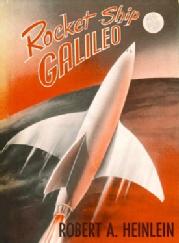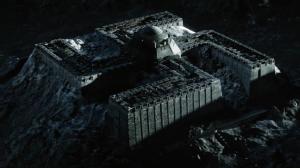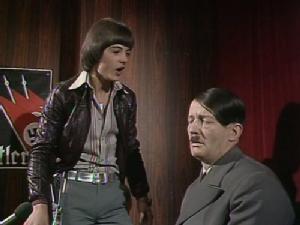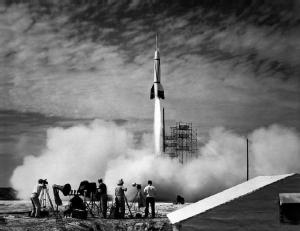Monsters in the Dark
Many dangers await astronauts venturing to the Moon, into the depths of space and into other regions of the unknown explored by science fiction. So why is the resurgence of threats from Earth and the darker aspects of humanity such a recurring theme? Why do we so often fear finding monsters of our own making in the dark?
[Warning: this blog post references events of the Second World War, which some may find distressing. While this is done in the context of science fiction and alternate histories, it is essential to remember the genocidal horrors perpetrated in our own reality. Exploring the role of National Socialism (and Soviet Russia) in fiction reminds us of these, and of the need to avoid the mistakes of the past.]
Nazis on the Moon
While both alien and human villains, conspiracies and fanatics, have featured in science fiction since it was first developed, a characteristic trope in science fiction is the idea that explorers in space might find secret human conspiracies waiting for them when they arrive. Perhaps unsurprisingly, in the decades following the Second World War, a common manifestation of this was the discovery of Space Nazis - fanatical survivors or descendents of Germany’s Third Reich under Adolf Hitler.
 Probably amongst the first examples of this was Robert A. Heinlein’s juvenile novel Rocket Ship Galileo (novel, 1947). This story imagines a former Manhattan Project scientist developing a new atomic rocket engine, and - finding himself unable to capitalise on his invention any other way - recruiting his young nephew and a group of other teenage engineers to build a ship. They eventually accompany him on humanity’s first trip to the Moon… only to find a Nazi base already there, and its personnel determined to kill them before launching a nuclear threat against the nations of Earth. Killing the Germans and disabling or capturing their rocket ships (Wotan and Thor) the Americans return to Earth as heroes.
Probably amongst the first examples of this was Robert A. Heinlein’s juvenile novel Rocket Ship Galileo (novel, 1947). This story imagines a former Manhattan Project scientist developing a new atomic rocket engine, and - finding himself unable to capitalise on his invention any other way - recruiting his young nephew and a group of other teenage engineers to build a ship. They eventually accompany him on humanity’s first trip to the Moon… only to find a Nazi base already there, and its personnel determined to kill them before launching a nuclear threat against the nations of Earth. Killing the Germans and disabling or capturing their rocket ships (Wotan and Thor) the Americans return to Earth as heroes.
Published in the aftermath of World War II, with the memory of German V-rocket weaponry fresh and a growing recognition of how technology had advanced during the years of conflict, this plot would have appeared substantially less unlikely than it does with the advantage of more than seventy years of hindsight.
Amidst numerous other Space Nazi stories, Philip K Dick’s The Man in the High Castle (novel, 1962, dramatised for television in 2015) imagines an alternate history in which American President Roosevelt was assassinated before the war, leading to a different direction through the conflict for the United States. As a result, Germany and Japan were victorious and German rocket development continued unabated, leading to sub-orbital intercontinental passenger rockets, and German visits to the Moon, Venus and Mars [3]. Similarly, Allen Steel’s V-S Day (novel, 2014) imagines an alternate path for the war in which both Germany and America prioritised rockets over nuclear development, resulting in the building of an ambitious Silbervogel sub-orbital space plane, and of the American X-1 (designed by rocket engineer Robert Goddard) to combat it. While in this case, the Nazis never reach the Moon, the novel makes it clear how close they might have come to space travel in the 1940s, and the potential impact that would have had for the future path of the world.
 The theme was, of course, famously returned to in the cult film Iron Sky (film, 2012). Set in 2018, a swastika-shaped base on the dark side of the Moon hosts an indoctrinated populace descended from Nazi-escapees who have lived with dreams of world dominance for decades. The film is an extended satire on modern society, including American politics and the growing extremism (either political or in terms of capitalist indulgences) in modern society. It critiques this at least in part by placing contemporary traits in contrast to the worst stereotypes and extremes of National Socialism, and pointing out how, even in such societies, good people can be misled and indoctrinated by those of evil-intent around them. The film also brings the technology and abuses of science of World War II Germany into sharp focus through their extrapolation across the intervening decades. Not only is there a pre-computer battle spaceship (which needs Earth-sourced smartphones to operate it), but also discussion of eugenics and a mad scientist with wild grey hair - ironically based on Albert Einstein, who fled from the Nazi genocide of people with Jewish descent.
The theme was, of course, famously returned to in the cult film Iron Sky (film, 2012). Set in 2018, a swastika-shaped base on the dark side of the Moon hosts an indoctrinated populace descended from Nazi-escapees who have lived with dreams of world dominance for decades. The film is an extended satire on modern society, including American politics and the growing extremism (either political or in terms of capitalist indulgences) in modern society. It critiques this at least in part by placing contemporary traits in contrast to the worst stereotypes and extremes of National Socialism, and pointing out how, even in such societies, good people can be misled and indoctrinated by those of evil-intent around them. The film also brings the technology and abuses of science of World War II Germany into sharp focus through their extrapolation across the intervening decades. Not only is there a pre-computer battle spaceship (which needs Earth-sourced smartphones to operate it), but also discussion of eugenics and a mad scientist with wild grey hair - ironically based on Albert Einstein, who fled from the Nazi genocide of people with Jewish descent.
On a more distant horizon, Star Trek explored the idea that a replica of German National Socialism might be introduced to another world. In the original series episode “Patterns of Force” (TV, 1968), a Federation administrator believed Nazi Germany to represent the most efficient form of government and attempted to implement limited aspects of its policies, but found his ideas distorted. The analogy of the Third Reich was instead taken to morally repugnant and genocidal extremes. Alongside questioning the right of one person to impose their views and values on a wider society, the story questions whether it is possible to extract elements of such a regime without falling prey to its extremes and their consequences.
Down to Earth
It is, of course, important not to consider these space-based stories in isolation. Pockets of surviving Nazi extremists in deep cave systems appear, for example, in an episode of tele-fantasy The Champions (“The Survivors”, TV, 1968) and in other spy-fi stories including the James Bond novel Moonraker (Ian Fleming, novel, 1955, [1]). Preserved (rather than merely surviving) Nazis are also a common trope in ground-based science fiction, providing opportunities for writers to explore both alien involvement with WWII and the science fictional technologies of cryogenics and cloning.
 In The Tomorrow People (“Hitler’s Last Secret”, TV, 1978) a cave-bound group of SS youths given anti-aging treatments in the last days of the war protect a cryogenically suspended Hitler (who, in fact, turns out to be an alien called Nebor). The group plan to use popular media, together with the alien’s hypnotic abilities, to retake control of the world - indeed a disturbing scene in the story involves one of the young Tomorrow People protagonists falling prey to the then-prevalent fashion for Nazi gear in the late 1970s and becoming hypnotised by its associations while the voice of Hitler rants in the background. In The New Avengers (“The Eagle’s Nest”, TV, 1976) and The Man from UNCLE (The Deadly Games Affair”, TV, 1964) groups of survivors or their descendants also try to arrange for the revival of a cryogenically-frozen führer, using the latest medical technologies and often-unwilling medical scientists.
In The Tomorrow People (“Hitler’s Last Secret”, TV, 1978) a cave-bound group of SS youths given anti-aging treatments in the last days of the war protect a cryogenically suspended Hitler (who, in fact, turns out to be an alien called Nebor). The group plan to use popular media, together with the alien’s hypnotic abilities, to retake control of the world - indeed a disturbing scene in the story involves one of the young Tomorrow People protagonists falling prey to the then-prevalent fashion for Nazi gear in the late 1970s and becoming hypnotised by its associations while the voice of Hitler rants in the background. In The New Avengers (“The Eagle’s Nest”, TV, 1976) and The Man from UNCLE (The Deadly Games Affair”, TV, 1964) groups of survivors or their descendants also try to arrange for the revival of a cryogenically-frozen führer, using the latest medical technologies and often-unwilling medical scientists.
Doctor Who novel Shadow in the Glass (Richards & Cole, novel, 2001) flirts with similar ideas of longevity before positing a Nazi base under the ice of Antarctica, with Hitler’s son raised there amidst supernatural superstition and under the influence of alien technology. By contrast, in The Boys from Brazil (novel, 1976; film, 1978) the dictator is instead cloned, with his several resulting “sons” raised separately and their lives managed in an attempt to recreate the same distorted personality traits.
Returning still closer to the source, a subset of science fictions explore the idea that the Nazis themselves were under an alien technological influence during the war itself. As well as the hypnotically-potent alien Hitler in The Tomorrow People, mentioned above, examples include Star Trek: Enterprise (“Storm Front”, TV, 2004, another defeated-US alternate history) and Galactica 1980 (“Galactica Discovers Earth”, TV, 1980), in both of which aliens attempt to accelerate German technological development for their own aims.
In all of these examples, the same messages are conveyed: the dangers of fanaticism, the role of propaganda and indoctrination in fostering it, the danger of misused technology… and the constant nagging fear that the vanquished enemy would return
Red Moons
While the feared German National Socialists continue to dominate in this arena - as Iron Sky and other twenty-first century examples demonstrate - they are not the only bogeyman science fiction sees lurking in the darkness. A similar role developed for the Soviet Union in the wake of the 1960s Space Race.
The Moonwinners is a children’s novel by James Muirden, published in 1965. As with most juvenile science fiction of its era, it features a teenage male protagonist, who becomes part of a rocket crew. In this example, a rocket from Russia beats the unawares Apollo 1 lander to the moon by a few days. The Russian astronauts are intended by their government to say hello when the Americans arrive in a greeting staged for the publicity value. Instead, both crews fall silent, and a British rocket is launched to discover why. To most of the characters, it appears obvious that the USSR is dissembling and responsible for the whole affair, but the real enemy turn out to be an extremist communist organisation, CRATER, which has infiltrated the whole world and taken over the Russian display of bravado. Cooperation between the non-CRATER astronauts of all three nations is required to remove the threat.
 A more established lunar occupation is encountered in the six-part radio drama Red Moon [2] - a Wireless Theatre production for BBC Radio in 2019, written by Robert Valentine. This is set in an alternate history in which the Soviet rocket designer Sergei Korolev was more successful in his tests and lived longer. As a result, the Soviets landed first on the Moon, and both the US and USSR developed nuclear moonbases. The story (set some time after the initial landing and at the height of Cold War tensions) concerns the discovery of a conspiracy that threatens dire consequences for both of these bases, and also threatens the Earth below. A near-identical opening premise underlies the recent Apple TV drama series For All Mankind (TV, 2019-present, first episode: also “Red Moon”), in which Korolev survives and Russia is first to the Moon landing, nuclear spaceflight develops and both Russia and the USA develop moon bases. The three seasons, each set in successive decades, explore the impact of these changes on the American space programme and on society more generally, with an increased emphasis on diversity in story-telling and the human-scale impacts of an altered Space Race.
A more established lunar occupation is encountered in the six-part radio drama Red Moon [2] - a Wireless Theatre production for BBC Radio in 2019, written by Robert Valentine. This is set in an alternate history in which the Soviet rocket designer Sergei Korolev was more successful in his tests and lived longer. As a result, the Soviets landed first on the Moon, and both the US and USSR developed nuclear moonbases. The story (set some time after the initial landing and at the height of Cold War tensions) concerns the discovery of a conspiracy that threatens dire consequences for both of these bases, and also threatens the Earth below. A near-identical opening premise underlies the recent Apple TV drama series For All Mankind (TV, 2019-present, first episode: also “Red Moon”), in which Korolev survives and Russia is first to the Moon landing, nuclear spaceflight develops and both Russia and the USA develop moon bases. The three seasons, each set in successive decades, explore the impact of these changes on the American space programme and on society more generally, with an increased emphasis on diversity in story-telling and the human-scale impacts of an altered Space Race.
Again, these narratives can be seen in the context of science fiction involving similar, Earth-based Soviet plots, including many in the spy-fi genre which imagine advanced technology developed in the USSR or by Soviet scientists elsewhere.
Fear of the Dark
So why are stories with Space Nazis (and to a lesser extent Space Soviets) so common and why do they continue to attract interest well into the twentieth century, with examples like Iron Sky and For All Mankind?
As always in speculative fiction, there is the irresistible “what if?” - the idea that small changes might cause large differences. Alternate histories provide a mechanism to question the path of societal development in the real world, and the cultural expectations and assumptions that have arisen in the years since the pivotal moment of change. The deeper the insecurity and divisions in contemporary society, the more likely it is to be attracted by alternatives, whether they suggest that a better present might have been possible, or whether they provide reassurance that this is the best of possible worlds. In this context, it is undeniable that allied victory in WWII and the climax of the Space Race marked two defining moments in the development of modern Western society. However this could be (and often is) explored in the context of a dozen other moments in the twentieth century and before.
 One element that makes science fiction involving National Socialist Germany particularly compelling is the acknowledged fact that Germany was a leading scientific nation before the war, and that its wartime research programmes both proposed and delivered ground-breaking technologies. The V-1 and V-2 vengeance weapons developed by the German rocketry programme were the most advanced technologies of their kind in the world at the time, and shocked the British in particular both by their destructive power and the implied technological edge they represented. Equally important, from the perspective of alternate histories, is the fact that this successful programme under Wernher von Braun did not so much end as merely relocate to the United States and continue under new management, becoming pivotal to the Space Race. As a result, the idea that victorious or secretive Germans could have developed their own space rocketry has an undeniable plausibility and fascination. Similarly, wartime interest from highly placed Nazis in Antarctica, in myths of the occult, and in hidden peoples such as those found underground in Edward Bulmer Lytton’s novel The Coming Race, provide a structural framework on which writers can base their fictional alternatives.
One element that makes science fiction involving National Socialist Germany particularly compelling is the acknowledged fact that Germany was a leading scientific nation before the war, and that its wartime research programmes both proposed and delivered ground-breaking technologies. The V-1 and V-2 vengeance weapons developed by the German rocketry programme were the most advanced technologies of their kind in the world at the time, and shocked the British in particular both by their destructive power and the implied technological edge they represented. Equally important, from the perspective of alternate histories, is the fact that this successful programme under Wernher von Braun did not so much end as merely relocate to the United States and continue under new management, becoming pivotal to the Space Race. As a result, the idea that victorious or secretive Germans could have developed their own space rocketry has an undeniable plausibility and fascination. Similarly, wartime interest from highly placed Nazis in Antarctica, in myths of the occult, and in hidden peoples such as those found underground in Edward Bulmer Lytton’s novel The Coming Race, provide a structural framework on which writers can base their fictional alternatives.
Going hand in hand with this plausibility is the association of German rocketry with warfare, and its consequent moral positioning. Fear of novel technology is often associated with fear of its misuse. In fact a key driver of science fiction is the exploration of the misuse of technology in the hypothetical, in order to inform its use in the actual. The fact that rockets were used aggressively against London in 1944, together with their later development in the field of intercontinental ballistic missiles, provides an association between space flight and villainy, or at the least moral ambiguity. That all modern rocket development can be traced back to Nazi technology, and the foundations of this technology in the genocidal treatment of slave labour under von Braun's directorship, and in ruthless weapons research, cannot be forgotten. Space Nazis can be seen as a personification of this dark side of rocketry (which can’t readily be invested in the machines themselves, but nonetheless retains a close association with them) rather than as a genuine source of fear in themselves. Similarly science fictions involving clones or cryogenically frozen remains of Hitler are challenging the audience to question the technology as much as the specific usage: if even this person can be revived, then is it worth the dangers? How can the technology be justified, regulated and such abuses avoided? Such questions are just reinforced by the genuine history of scientific misuses and abuses - particularly in the immoral experimentation undertaken by some Nazi scientists and doctors.
At the height of the Cold War nuclear proliferation, Soviet Russia may also have been a source of fear regarding the misuse of their advanced (although not usually superior) technology. However their continued appearance alongside Nazi Germany in science fiction may hint at additional factors in the interpretation of such science fiction. Both Antarctica and the depths of space are essentially blank slates - screens onto which to project our own fears and anxieties.
In the years, or even decades, immediately following the Second World War, fear that pockets of Nazis might have survived were perhaps reasonable, and outer space or the Moon provided a conveniently distant setting in which to explore the idea, without the complications of an urban or national political setting. That both the Nazi Reich and the Soviet Union have appeared in science fiction long after they ceased to exist might suggest that they articulate a deeper fear - the same fear that associates darkness (and hence the darkness of space) with evil, demons and dread. For some writers and audiences, Nazis or Soviets provide a more comprehensible, and perhaps more plausible, way to personify that dread than imagining the alien aggressors that spring from the same terror of the unknown and unseen. Such stories are also a warning against complacency - a reminder (particularly in the case of the Nazis) of the evil of which humanity is capable.
There is likely no single reason why we see monsters in the dark, whether they are Nazis, Soviets or others. As with so much science fiction, there is a complex web of motivations, most of which reflect more on the contemporary society in which they were written than the subject matter. However it is undeniable that both the advanced technology of the German Third Reich and the depths of its crimes provide a particularly compelling source for such story-telling. Combining these elements allows writers to warn about the dangers of scientific advance without moral, practical and societal restraint - one of the core themes of all science fiction narratives.
“Monsters in the Dark”, Elizabeth Stanway. Cosmic Stories blog. 2nd July 2023
Notes:
[1] Note that the original novel of Moonraker involved the then-conventional technology of intercontinental missiles rather than space rockets. The space station and other orbital elements appearing in the 1979 James Bond film of the same name were introduced during the screenplay development, which also changed the background and motivation of the originally-Nazi main protagonist, Drax. [Return to text]
[2] Note that this Red Moon story has no connection to the Kim Stanley Robinson 2018 novel of the same name, which instead explores the impact of a Chinese lead in lunar colonizations. [Return to text]
[3] Unusually, The Man in the High Castle is an alternate history novel, set in a world in which the Axis powers won WWII, which is largely about an alternate history novel, set in a world in which the Axis powers lost WWII. [Return to text]
The views expressed here are my own and not necessarily those of the University of Warwick. All images sourced from public sites online and are used for commentary and criticism.
